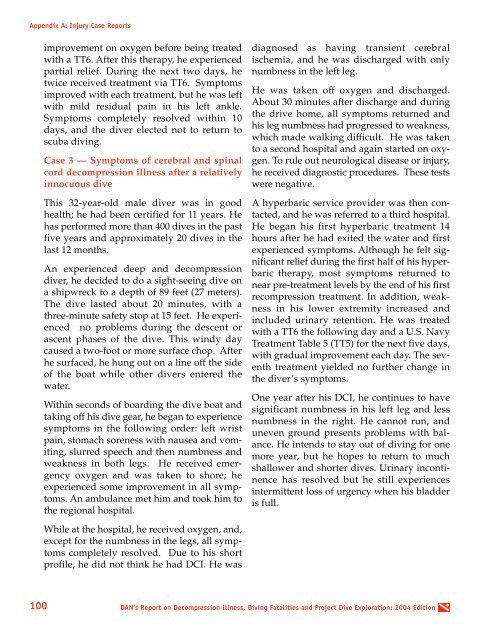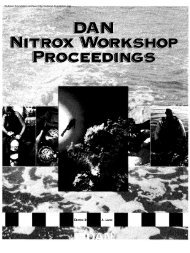Report on Decompression Illness, Diving Fatalities and Project Dive
Report on Decompression Illness, Diving Fatalities and Project Dive
Report on Decompression Illness, Diving Fatalities and Project Dive
- No tags were found...
You also want an ePaper? Increase the reach of your titles
YUMPU automatically turns print PDFs into web optimized ePapers that Google loves.
Appendix A: Injury Case <str<strong>on</strong>g>Report</str<strong>on</strong>g>simprovement <strong>on</strong> oxygen before being treatedwith a TT6. After this therapy, he experiencedpartial relief. During the next two days, hetwice received treatment via TT6. Symptomsimproved with each treatment, but he was leftwith mild residual pain in his left ankle.Symptoms completely resolved within 10days, <strong>and</strong> the diver elected not to return toscuba diving.Case 3 — Symptoms of cerebral <strong>and</strong> spinalcord decompressi<strong>on</strong> illness after a relativelyinnocuous diveThis 32-year-old male diver was in goodhealth; he had been certified for 11 years. Hehas performed more than 400 dives in the pastfive years <strong>and</strong> approximately 20 dives in thelast 12 m<strong>on</strong>ths.An experienced deep <strong>and</strong> decompre s s i o ndiver, he decided to do a sight-seeing dive <strong>on</strong>a shipwreck to a depth of 89 feet (27 meters).The dive lasted about 20 minutes, with athree-minute safety stop at 15 feet. He experiencedno problems during the descent orascent phases of the dive. This windy daycaused a two-foot or more surface chop. Afterhe surfaced, he hung out <strong>on</strong> a line off the sideof the boat while other divers entered thewater.Within sec<strong>on</strong>ds of boarding the dive boat <strong>and</strong>taking off his dive gear, he began to experiencesymptoms in the following order: left wristpain, stomach soreness with nausea <strong>and</strong> vomiting,slurred speech <strong>and</strong> then numbness <strong>and</strong>weakness in both legs. He received emergencyoxygen <strong>and</strong> was taken to shore; heexperienced some improvement in all symptoms.An ambulance met him <strong>and</strong> took him tothe regi<strong>on</strong>al hospital.diagnosed as having transient cere b r a lischemia, <strong>and</strong> he was discharged with <strong>on</strong>lynumbness in the left leg.He was taken off oxygen <strong>and</strong> discharged.About 30 minutes after discharge <strong>and</strong> duringthe drive home, all symptoms returned <strong>and</strong>his leg numbness had progressed to weakness,which made walking difficult. He was takento a sec<strong>on</strong>d hospital <strong>and</strong> again started <strong>on</strong> oxygen.To rule out neurological disease or injury,he received diagnostic procedures. These testswere negative.A hyperbaric service provider was then c<strong>on</strong>tacted,<strong>and</strong> he was referred to a third hospital.He began his first hyperbaric treatment 14hours after he had exited the water <strong>and</strong> firstexperienced symptoms. Although he felt significantrelief during the first half of his hyperbarictherapy, most symptoms returned t<strong>on</strong>ear pre-treatment levels by the end of his firstrecompressi<strong>on</strong> treatment. In additi<strong>on</strong>, weaknessin his lower extremity increased <strong>and</strong>included urinary retenti<strong>on</strong>. He was treatedwith a TT6 the following day <strong>and</strong> a U.S. NavyTreatment Table 5 (TT5) for the next five days,with gradual improvement each day. The seventhtreatment yielded no further change inthe diver’s symptoms.One year after his DCI, he c<strong>on</strong>tinues to havesignificant numbness in his left leg <strong>and</strong> lessnumbness in the right. He cannot run, <strong>and</strong>uneven ground presents problems with balance.He intends to stay out of diving for <strong>on</strong>emore year, but he hopes to return to muchshallower <strong>and</strong> shorter dives. Urinary inc<strong>on</strong>tinencehas resolved but he still experiencesintermittent loss of urgency when his bladderis full.While at the hospital, he received oxygen, <strong>and</strong>,except for the numbness in the legs, all symptomscompletely resolved. Due to his shortprofile, he did not think he had DCI. He was100DAN’s <str<strong>on</strong>g>Report</str<strong>on</strong>g> <strong>on</strong> Decompressi<strong>on</strong> <strong>Illness</strong>, <strong>Diving</strong> <strong>Fatalities</strong> <strong>and</strong> <strong>Project</strong> <strong>Dive</strong> Explorati<strong>on</strong>: 2004 Editi<strong>on</strong>
















